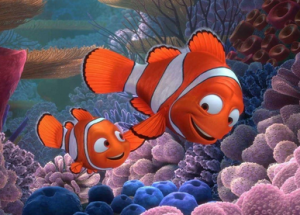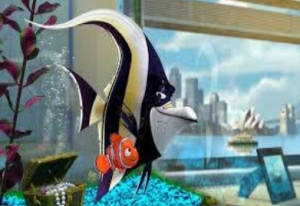38 Finding Nemo (2003)
Representing Disability in Finding Nemo
By Omar Garcia
A classical Disney tale, Finding Nemo is an animated film from the collaboration between Walt Disney and Pixar Animation Studios. The story opens darkly as Marlin the clownfish loses his wife and all but one of their eggs to a predator. The scene inserts a close-up shot, allowing the audience to acknowledge that Marlin only had one egg that survived the attack. The close-up shot helps display more in-depth details, allowing the audience to identify the crack on the fish egg, giving an insight that despite it being the only egg that survived the attack, the egg was injured during the attack. This helps put in perspective that the fish, who is introduced as Nemo may grow up with a disability. Nemo later gets separated from his father, Marlin by the intervention of a scuba diver, and is held captive in a fish tank. Marlin later goes on an underwater voyage to find his missing son Nemo who also suffers from a disability. Along Marlin’s voyage, he encounters different fish who represent different disabilities and have personas that convey a variety of social styles. Through my analysis, I will enhance the concept that Finding Nemo highlights disabilities and defects in a positive aspect.
The representation of disability is presented as a socially created concept, rather than a state of the body to which value judgments are assigned. This can helps portray disability as an ingredient in cultural diversity. Through my analysis of different characters that are presented during the film, I will enhance the concept that Finding Nemo addresses many social issues that disabled individuals face. I will focus on those individuals in a positive aspect that highlights that although they are marked as visually and socially different, they are far from being inadequate. I will highlight the characters’ power to overcome barriers, despite preconceived notions about their role in society. I will use different characters that Marlin encounters along his voyage, as well as the ones Nemo encounters during his journey. I will examine both Nemo and Gill who share the same physical disability, Marlin’s sidekick Dory, who suffers from chronic short-term memory loss, and Marlin who suffers from being emotionally disabled.

In the story, Nemo displays a deformed fin, a corporeal characteristic that marks Nemo. Despite Nemo being marked visually and socially different, his deformed fin doesn’t keep him from being inadequate. Nemo, “explains that he has a lucky fin when questioned by his classmates, who then offer their explanations of distinctive physical quirks (Millett)”. Nemo is accepted by his peers and even admired for his self-confidence, highlighting disability in a positive light. This helps allow disability to be presented as a socially constructed concept. Later in the film, Nemo is separated from his father Marlin, by the intervention of a scuba diver and held captive in a fish tank. While captive in the fish tank, Nemo meets a diverse group of fish from all different backgrounds. However, one fish, in particular, can relate to Nemo on a different level. Gill is a Moorish idol fish, who also suffers from the same physical disability as Nemo, both suffering from a deformed fin.
Gill’s presence in the film is dark and mysterious, the film utilizes sound and camera angles to enhance the mysterious presence of Gill. Although Gill may be mysterious he plays an important role in teaching Nemo an important lesson about self-worth. He helps Nemo overcome his perception of his disabilities. Gill’s plan to escape the fish tank relies on Nemo being able to overcome the conception of his disability, pushing Nemo to realize that despite his disability he still has effectiveness. This helps highlight disability as a social construct character quality rather than a limitation. Gill’s role in the film allows viewers to make the correlation of both fish overcoming adversity. Nemos and Gill’s relationship with their deformed fin represents that although they are marked as visually and socially different, they are far from being inadequate, striking at the misconceptions that disability correlates to insufficiency. Gill and Nemo were able to be successful in their plan as they encouraged their disabilities to keep moving forward. Gill was able to encourage Nemo to embrace his adversity. Marlin before this point would always remind Nemo what his limitations were. Gill was able to understand Nemo from his perception and was able to persuade Nemo to overcome his perception of his disability.

On the pursuit to find Nemo, Marlins come across Dory, a Pacific regal blue tang who becomes Marlin’s sidekick on the voyage to find Nemo. Dory has chronic short term memory loss. Although Dory can remember through adaptive problem solving when it’s essential. Allowing for her abnormality to become an essential key in the plot of Finding Nemo. Dory is easily one of the most recognizable and popular characters from the film, therefore it was essential for Dory to be able to embrace her adversity. It’s important as “how individuals are portrayed in popular media can have a profound effect on how they are viewed by society at large (IRIS Films: Portrayals of People with Disabilities)”. This helps drive the storyline forward. Marlin during the film recognizes Dory’s value despite her adversity and suggests how he wouldn’t have been able to complete the journey and Find Nemo without her help.
Marlin’s doubt about Dory’s abilities can correlate with the assumption of disabled people being underestimated. Dory proves that limitations in one area don’t mean limitations in every aspect of one’s life, and in certain circumstances, these limitations can be overcome. Dory proves that even through limitations each person brings indispensable strengths. The film allows viewers insight into Dory’s value and Marlins evolving relationships with Dory’s disability. Despite many times during the film, Marlin doubts and questions Dory’s ability to be an asset on his voyage. Dory continues to prove she is vital as she initiates communication with other species that help result in progress for the voyage to Finding Nemo. She overcomes Marlins Prejudiced behavior and displays her abnormality as essential in the voyage despite preconceived notions about her role. Allows the viewers to see disabilities and defects in a positive light. Dory learns that despite her limitations she can still be an important asset, and is eventually the one who finds Nemo.
Marlin proves to be emotionally disabled from the traumatic loss of his wife, and eggs. “Like many single parents who have survived a tragedy, Marlin turns neurotically overprotective of his son (Germain, 2003)”. Marlin helps represent the struggle with chronic anxiety, and the effect it has on relationships. Marlin experiencing a tragic encounter, caused him to be emotionally disabled, exemplified by Marlin’s loving but damaging overprotection of Nemo. Marlin often avoids social interaction and enacts Nemos social exclusion, which causes rifts in their relationship. “Nemo continually negotiates and battles restrictive assumptions about him based on his impaired fin (Millett)”. Although throughout the film Marlin is constantly evolving himself, and overcoming his preconceived notion. This helps highlight that although individuals are marked as visually and socially different, they are far from being inadequate.
The film brings elements of adversity and proves to be an unconventional representation of disability. As Millet notes, “The story has a genuine emotional depth and its psychological furniture is logical and appropriate” (Millett). When taking a deeper look into the story and the characters in Finding Nemo, there are very diverse characters representing different disabilities. The film presents disabilities and defects in a positive aspect. “Finding Nemo offers as much in terms of thrills, frights, humor, and psychological insight as it does in pure technical skill, proving that a movie can be art” (Norman & Evening Standard, 2012).
Finding Nemo, highlights disabilities, and defects in a positive aspect. The film presents disability as a socially created concept, rather than a state of the body to which value judgments are assigned. This can help portray disability as an ingredient in cultural diversity. The film allows the characters to realize their potential despite their disabilities. The film highlights that although they are marked as visually and socially different, they are far from being inadequate. This allows the characters to break through the preconceived notions about their disabilities. The film highlights the power that each individual has to break their misconceptions.
Sources
Millett, A. (n.d.). Finding Nemo. Retrieved November 26, 2020, from https://dsq-sds.org/article/view/873/1048
Germain, D. (2003, October 29). At the Movies – ‘Finding Nemo’. Retrieved November 26, 2020, from https://www.semissourian.com/story/110310.html
Films: Portrayals of People with Disabilities. (n.d.). Retrieved November 26, 2020, from https://iris.peabody.vanderbilt.edu/resources/films/
Norman, N., & Evening Standard. (2012, April 10). A fabulously fishy tale. Retrieved November 26, 2020, from https://www.standard.co.uk/go/london/film/a-fabulously-fishy-tale-7436665.html
.

